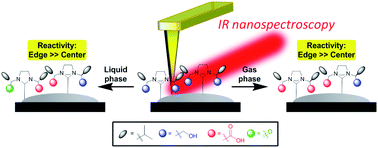当前位置:
X-MOL 学术
›
Chem. Sci.
›
论文详情
Our official English website, www.x-mol.net, welcomes your feedback! (Note: you will need to create a separate account there.)
Identifying site-dependent reactivity in oxidation reactions on single Pt particles†
Chemical Science ( IF 8.4 ) Pub Date : 2018-07-03 00:00:00 , DOI: 10.1039/c8sc01956h Shahar Dery 1, 2 , Suhong Kim 3 , David Haddad 1, 2 , Albano Cossaro 4 , Alberto Verdini 4 , Luca Floreano 4 , F Dean Toste 3 , Elad Gross 1, 2
Chemical Science ( IF 8.4 ) Pub Date : 2018-07-03 00:00:00 , DOI: 10.1039/c8sc01956h Shahar Dery 1, 2 , Suhong Kim 3 , David Haddad 1, 2 , Albano Cossaro 4 , Alberto Verdini 4 , Luca Floreano 4 , F Dean Toste 3 , Elad Gross 1, 2
Affiliation

|
Catalytic nanoparticles are heterogeneous in their nature and even within the simplest particle various surface sites exist and influence the catalytic reactivity. Thus, detailed chemical information at the nanoscale is essential for understanding how surface properties and reaction conditions direct the reactivity of different surface sites of catalytic nanoparticles. In this work, hydroxyl-functionalized N-heterocyclic carbene molecules (NHCs) were anchored to the surface of Pt particles and utilized as chemical markers to detect reactivity variations between different surface sites under liquid and gas phase oxidizing conditions. Differences in the chemical reactivity of surface-anchored NHCs were identified using synchrotron-radiation-based infrared nanospectroscopy with a spatial resolution of 20 nanometers. By conducting IR nanospectroscopy measurements, along with complementary spatially averaged IR and X-ray spectroscopy measurements, we identified that enhanced reactivity occurred on the particles' periphery under both gas and liquid phase oxidizing conditions. Under gas phase reaction conditions the NHCs' hydroxyl functional groups underwent preferential oxidization to the acid along the perimeter of the particle. Exposure of the sample to harsher, liquid phase oxidizing conditions induced modification of the NHCs, which was mostly identified at the particle's periphery. Analysis of X-ray absorption spectroscopy measurements revealed that exposure of the sample to oxidizing conditions induced aromatization of the NHCs, presumably due to oxidative dehydrogenation reaction, along with reorientation of the NHCs from perpendicular to parallel to the Pt surface. These results, based on single particle measurements, demonstrate the high reactivity of surface sites that are located at the nanoparticle's periphery and the influence of reaction conditions on site-dependent reactivity.
中文翻译:

识别单个 Pt 颗粒氧化反应中的位点依赖性反应性†
催化纳米粒子本质上是异质的,即使在最简单的粒子内,也存在各种表面位点并影响催化反应性。因此,纳米级的详细化学信息对于了解表面性质和反应条件如何指导催化纳米粒子不同表面位点的反应性至关重要。在这项工作中,羟基官能化的 N-杂环卡宾分子 (NHC) 被锚定在 Pt 颗粒的表面,并用作化学标记物来检测液相和气相氧化条件下不同表面位点之间的反应性变化。使用空间分辨率为 20 纳米的基于同步辐射的红外纳米光谱法确定了表面锚定的 NHC 化学反应性的差异。通过进行 IR 纳米光谱测量,以及互补的空间平均 IR 和 X 射线光谱测量,我们发现在气相和液相氧化条件下,颗粒外围发生了增强的反应性。在气相反应条件下,NHC 的羟基官能团沿颗粒周边优先氧化成酸。将样品暴露在更苛刻的液相氧化条件下会引起 NHC 的改变,这主要在颗粒的外围被识别出来。X 射线吸收光谱测量分析表明,样品暴露于氧化条件下会引起 NHC 芳构化,这可能是由于氧化脱氢反应,随着 NHC 从垂直到平行于 Pt 表面的重新定向。这些基于单粒子测量的结果证明了位于纳米粒子外围的表面位点的高反应性以及反应条件对位点依赖性反应性的影响。
更新日期:2018-07-03
中文翻译:

识别单个 Pt 颗粒氧化反应中的位点依赖性反应性†
催化纳米粒子本质上是异质的,即使在最简单的粒子内,也存在各种表面位点并影响催化反应性。因此,纳米级的详细化学信息对于了解表面性质和反应条件如何指导催化纳米粒子不同表面位点的反应性至关重要。在这项工作中,羟基官能化的 N-杂环卡宾分子 (NHC) 被锚定在 Pt 颗粒的表面,并用作化学标记物来检测液相和气相氧化条件下不同表面位点之间的反应性变化。使用空间分辨率为 20 纳米的基于同步辐射的红外纳米光谱法确定了表面锚定的 NHC 化学反应性的差异。通过进行 IR 纳米光谱测量,以及互补的空间平均 IR 和 X 射线光谱测量,我们发现在气相和液相氧化条件下,颗粒外围发生了增强的反应性。在气相反应条件下,NHC 的羟基官能团沿颗粒周边优先氧化成酸。将样品暴露在更苛刻的液相氧化条件下会引起 NHC 的改变,这主要在颗粒的外围被识别出来。X 射线吸收光谱测量分析表明,样品暴露于氧化条件下会引起 NHC 芳构化,这可能是由于氧化脱氢反应,随着 NHC 从垂直到平行于 Pt 表面的重新定向。这些基于单粒子测量的结果证明了位于纳米粒子外围的表面位点的高反应性以及反应条件对位点依赖性反应性的影响。



























 京公网安备 11010802027423号
京公网安备 11010802027423号